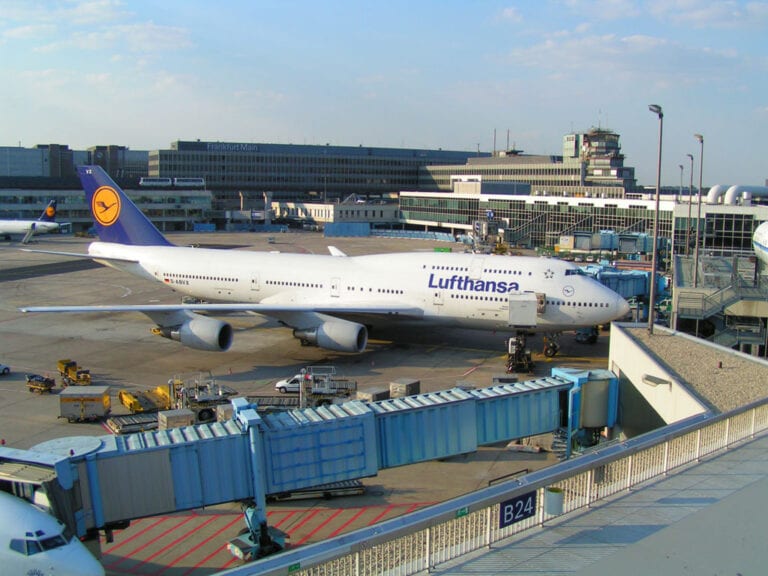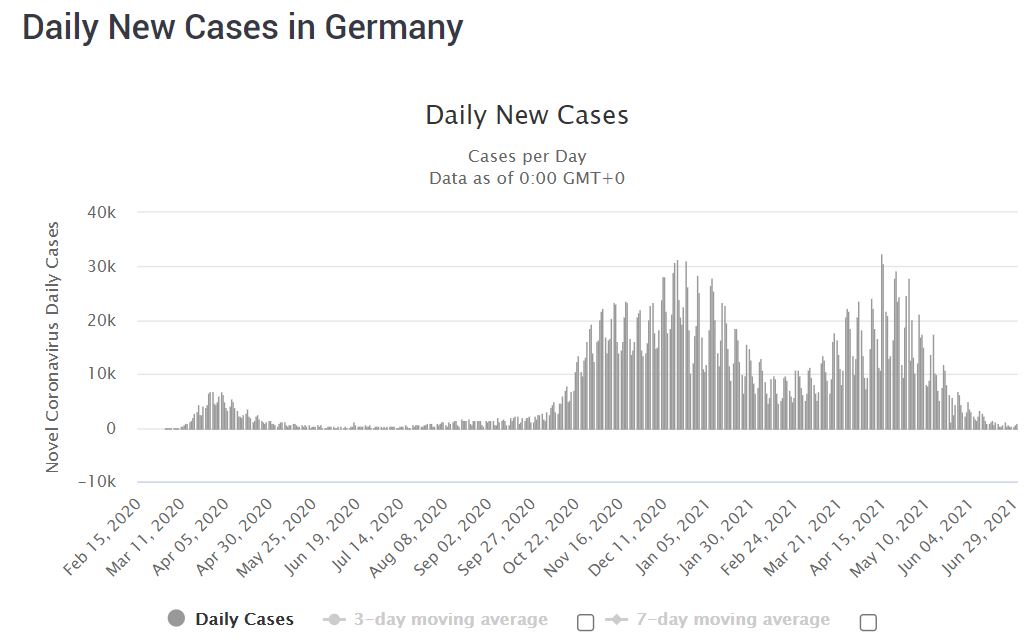Germany is open to visitors from the EU, Schengen and a few third-party countries. Different entry restrictions apply to “different areas of concern.” (See details on Countries, areas and territories of concern section).
Travelers arriving in Germany who have spent time in a risk area within 10 days prior to entry are subjected to a mandatory COVID-19 test and might need to quarantine.
Germany reopening – Latest updates
July 1 – Germany reopened to American tourists on June 25 but demands on U.K. visitors
Last week, German authorities decided to reopen its international borders to fully vaccinated Americans and other non-EU low-risk countries, unless they are visiting from a virus-variant area of concern.
Those with travel history to an RKI-designated risk area in the 10 days prior to entry are required to submit a digital registration proving they had an urgent or exceptional need to travel to Germany.
As of today, all visitors six years or older must either submit proof of vaccination, a negative COVID-19 test, or proof of recovery from the virus. Travelers must have received two full series of a vaccine no less than 14 days prior to arrival. (Source: US embassy)
On the other hand, Germany is reportedly demanding EU Member States to ban UK visitors due to the spread of the highly-contagious Delta variant in its territory.
June 12 – Germany started rolling out a digital vaccine passport this week.
Germany enforces some of the strictest domestic COVID-19 restrictions across Europe. Before going out for lunch, staying at a hotel, or working out at a gym, Germans must take a COVID-19 test and produce a negative result.
This week the country started rolling out a new digital vaccine passport named CovPass that will let users download proof of their coronavirus vaccination certificate onto the app.
After receiving a QR code, visitors and locals will be allowed easy access to restaurants, museums or other tourist venues that require proof of immunization.
Health Minister Jens Spahn said that this digital vaccination pass is “an important step for the revival of international tourist travel.”
(Source)
May 29 – Germany imposed new travel restrictions to U.K. travelers since May 23
The E.U. is finishing up a plan to ease travel within the bloc for those who have been vaccinated, recovered or can produce a negative COVID-19 test. Effective July 1, all EU countries will be required to accept these certificates.
Some EU tourist-dependent countries have moved ahead and reopened their doors to international travelers. But Germany is not one of them. Instead, it has recently imposed a new travel ban to visitors from the U.K., Northern Ireland, and some other countries.
“…There are local outbreaks occurring again, including cases of more infectious variants such as the Indian variant at present. Therefore, to prevent the further spread of the virus, the United Kingdom has been classified as an area of variant of concern with effect from May 23, 2021,” reads the government statement.
So far, Germany has just started to lift some local restrictions. But the date of a broader international reopening has not been announced.
(Source: SchengenVisaInfo News)
May 21 – Schleswig-Holstein is the first German State fully reopening for tourism
After experimenting with small groups of tourists, Germany has fully reopened its northernmost state of Schleswig-Holstein for tourism. Bars and restaurants are reopened for both indoor and outdoor dining, and boat trips and other tourist attractions are open for business again.
Rules are still tough. All visitors must bring a COVID-19 negative test, proof of having received two doses of an approved vaccine against COVID-19, and agree to get retested every 3 days.
Also, last Monday the country reopened bars and restaurants nationwide. Again, customers must bring the same certificates or they will be denied service.
April 20 – Germany to unify local and national restrictions to fight the third wave of COVID-19
Germany, as usual, is taking very seriously the third wave of COVID-19 cases they have started to see over the last couple of weeks.
A few days ago, the Cabinet members approved legal changes to grant the federal government enough power to enforce consistent COVID-19 related restrictions over all German states. This means that all regions no matter how big or small they are will need to comply with the new federal laws, now called the “federal emergency brake.”
“We must not ignore the cries for help from the medical profession. They need us,” […] “Our fight against the pandemic needs to be stricter and more resolute,” […] “The nationwide emergency brake is long overdue,” said Chancellor Angela Merkel, while emphasizing that Germany is “approaching the light at the end of the tunnel.”
Countries, areas and territories of “concern”
Germany has changed its color-code classification to new “areas of variant of concern”, “high incidence areas”, “risk areas” and 2 regions that are no longer considered as risk areas.” This list will be effective from June 13 at 00:00.
1. New virus variant areas – areas with a particularly high risk of infection due to the widespread occurrence of certain SARS-CoV-2 virus variants:
- Portugal (including the autonomous regions of Madeira and Azores) is now considered a virus variant area.
- The Russian Federation is now considered a virus variant area.
2. New high incidence areas – areas with a particularly high risk of infection due to particularly high incidences for the spread of the SARS-CoV-2 coronavirus:
- No new high incidence areas since the last change (see current list below).
3. New simple risk areas – areas with increased SARS-CoV-2 infection risk:
- Fiji is now considered an easy risk area.
- Croatia – Zadar County is now considered an easy risk area.
- Rwanda is now considered a simple risk area.
4. Areas that are no longer considered risk areas:
- Denmark is no longer a risk area.
- Croatia – Varaždin County is no longer considered a risk area.
- Latvia is no longer considered a risk area.
- Luxembourg is no longer a risk area.
- The Netherlands is no longer a risk area (the overseas parts of the Kingdom of Netherlands Aruba and Sint Maarten are still excluded).
- Sweden – all of Sweden with the exception of the provinces Kronoberg, Norrbotten and Värmland are no longer considered a risk area.
- Slovenia is no longer considered a risk area.
(Source)
Can Americans visit Germany?
US citizens are allowed to visit Germany from June 25, 2021.
What are the restrictions in Germany for travelers visiting from a risk area?
Visitors coming from a risk area -even if it is in an unrestricted country- have to,
- Submit proof of a negative COVID-19 test taken within the 48 hours prior to arrival to avoid quarantine.
- Take an additional test if the one the visitor brings does not meet the German standards.
- Quarantine.
Current COVID-19 situation in Germany
Germany has reported 3,736,223 positive cases and 91,459 deaths since the pandemic struck.
What activities are banned during national lockdown?
Tourist and social activities
From 6 April, the Federal State of Saarland reopened tourist venues such as bars, restaurants, cinemas, and sport facilities, with the condition that a negative rapid test result for COVID-19 infection is presented upon entry.
Reopening Schedule?
Retail, museums, galleries, zoos and botanical gardens can reopen with appointments.
Outdoor dining, theatres, concert halls, opera houses, cinemas, and sport events. Attendants may need to provide a rapid test depending on the epidemiological numbers of the region.
For further information click here.
Related:
– Is Austria open for tourism?
– Czechia reopening Borders
– Is Poland open for tourism?


